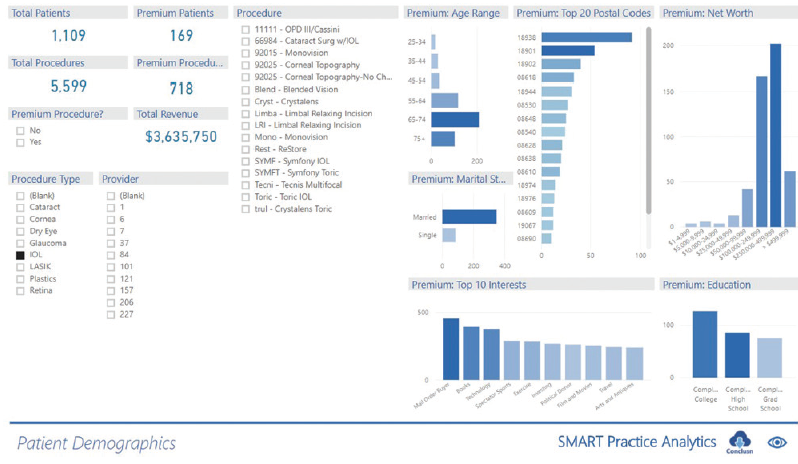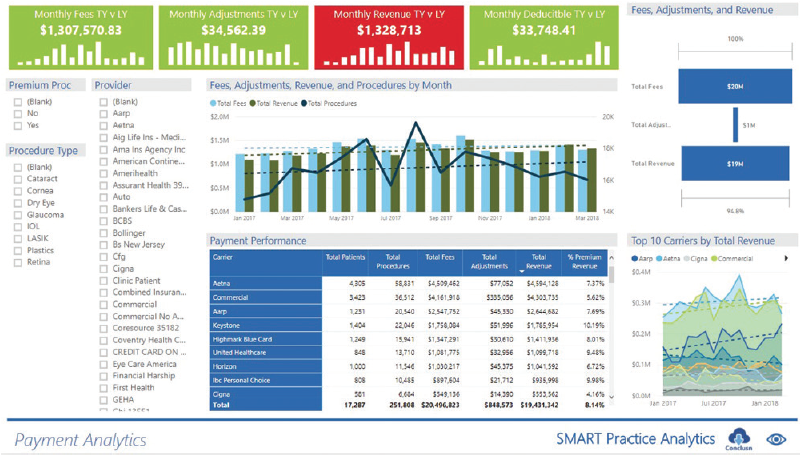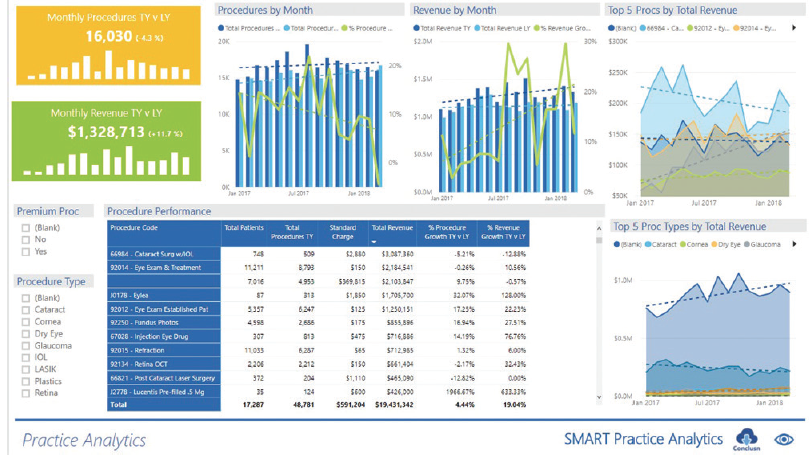
The adoption rate for electronic medical record (EMR) and electronic practice management systems has been increasing steadily among ophthalmologists over the past 5 years. Basic patient demographic information, referral sources, medical diagnoses, and treatment plans are easily retrieved from current electronic health record (EHR) systems. Getting started with EHRs, however, demands time, money, and an emotional commitment by the practice, its physicians, and its staff. Net revenue and productivity decrease and costs rise while a practice implements an EHR system. Moreover, there is a disconnect in terms of needs. Vendors focus on designing systems to satisfy meaningful use requirements, the Merit-based Incentive Payment System, the Medicare Access and CHIP Reauthorization Act, the Physician Quality Reporting System, and so on. In contrast, physicians and practice administrators want to extract customized information to better manage their businesses.
AT A GLANCE
- Although electronic medical record, electronic health record, and electronic practice management systems contain huge amounts of information, accessing it remains challenging.
- A new approach can obtain and analyze data to provide insight into a practice’s market and patient base, increase efficiency, and guide business growth.
Although EMR, EHR, and electronic practice management systems contain huge amounts of information, accessing it remains challenging. To enhance workflow efficiency, I realized that my practice needed a more organized and customizable approach to data retrieval. Because my EHR vendor could not provide this to us, I found an outside company, Conclusn (www.conclusn.com), with which to collaborate.
To my mind, if you know who your patients are, what made them select your practice, why they may be willing to purchase premium procedures or treatments, and why they may decide to buy other retail products from your office, your practice can focus better on serving your patients’ needs. There are multiple ways for a practice to take advantage of this information to improve efficiency and patient throughput.
BARRIER TO ACCESS
The biggest challenge is that most EMR and EHR systems have the practice’s data tied up in a server that the practice owns and has access to but that it is unable to do anything with outside of what the EMR or EHR service provides. Most, if not all, services do not support analysis of data deeper than name, address, health plan, dates of service, diagnoses, and treatment plan. This information does not assist with strategic planning, performance improvement, or uncovering hidden gems for executive decision-making. The reporting from EMR and EHR databases is basic. Often, it follows a generic template developed by a nonophthalmologist who is keeping the EMR or EHR system in mind instead of the needs of an individual practice.
SIMPLIFYING DATA MINING
The meeting with Conclusn made me realize that my EHR system held information that I could use to better understand my market and my patient base. I learned about how big companies mine their customer data to fine-tune their business models and deliver services in a manner customized to their patients. Health care recently started to explore big data, but only at the larger provider level. Conclusn uses Fortune 500 analytics to provide the analysis and customized dashboard reporting that CEOs use to lead their companies. Smart analytics is a way to identify the patients most likely to choose premium procedures and treatment options.
First, as a sample, my practice provided Conclusn with comprehensive patient data spanning a 1-year period in a HIPAA-compliant manner. Next, we analyzed the data and determined what we wanted to review. We identified metrics such as the locations of our patients, OD referral patterns, standard cataract procedures versus premium upgrades, and ocular surface treatment options. We then evaluated differences between the profiles of patients who elected a premium offering and those who did not and developed a dashboard to understand how we might attract more of the former to our practice. Finally, we uploaded my practice’s total patient database into the analytical machine that Conclusn built for us.
We found that the use of several data points helps to increase practice efficiency. For example, we can identify in real time specific centers such as refractive corneal surgery, cataract with advanced technology implants, use of the »LipiFlow Thermal Pulsation System (Johnson & Johnson Vision), and oculoplastics procedures and compare them among our different locations simply by letting the cursor hover over the graph. In the same manner, we can review profitability and growth by doctor, office, and procedure (Figures 1–3). In this way, we have identified at which of our locations dry eye treatment is most likely to be accepted, and we have targeted our patient education seminars on that subject to those zip codes.

Figure 1. Sample report on patient demographics.

Figure 2. Example of payment analytics.

Figure 3. Example of practice analytics.
A LEARNING EXPERIENCE
This experience showed me that you really don’t know what you don’t know! Like paper charts, EMRs and EHRs store patient data and record clinical visits and surgical procedures, but vendors have not done much to help physicians and their staff members understand their practices and patients better. Conclusn can use the stored data to help a practice map out where to go.
NEXT STEPS
Our initial approach was to gain a better understanding of my practice’s premium market. Additional applications are to incorporate the financial and operational performance analytics needed to improve business growth. Practices can use the dashboard to identify where to build a satellite office or surgery center. The customization of Conclusn services will be unique to every practice.




